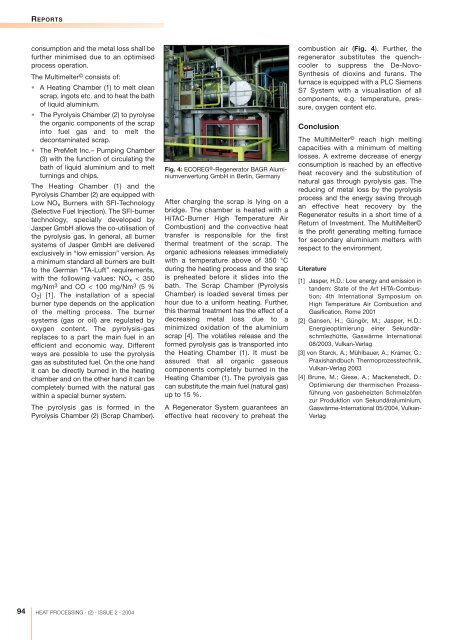The new generation of aluminium melting furnaces - Jasper GmbH
The new generation of aluminium melting furnaces - Jasper GmbH
The new generation of aluminium melting furnaces - Jasper GmbH
Create successful ePaper yourself
Turn your PDF publications into a flip-book with our unique Google optimized e-Paper software.
94<br />
REPORTS<br />
consumption and the metal loss shall be<br />
further minimised due to an optimised<br />
process operation.<br />
<strong>The</strong> Multimelter © consists <strong>of</strong>:<br />
• A Heating Chamber (1) to melt clean<br />
scrap, ingots etc. and to heat the bath<br />
<strong>of</strong> liquid <strong>aluminium</strong>.<br />
• <strong>The</strong> Pyrolysis Chamber (2) to pyrolyse<br />
the organic components <strong>of</strong> the scrap<br />
into fuel gas and to melt the<br />
decontaminated scrap.<br />
• <strong>The</strong> PreMelt Inc.– Pumping Chamber<br />
(3) with the function <strong>of</strong> circulating the<br />
bath <strong>of</strong> liquid <strong>aluminium</strong> and to melt<br />
turnings and chips.<br />
<strong>The</strong> Heating Chamber (1) and the<br />
Pyrolysis Chamber (2) are equipped with<br />
Low NOx Burners with SFI-Technology<br />
(Selective Fuel Injection). <strong>The</strong> SFI-burner<br />
technology, specially developed by<br />
<strong>Jasper</strong> <strong>GmbH</strong> allows the co-utilisation <strong>of</strong><br />
the pyrolysis gas. In general, all burner<br />
systems <strong>of</strong> <strong>Jasper</strong> <strong>GmbH</strong> are delivered<br />
exclusively in “low emission” version. As<br />
a minimum standard all burners are built<br />
to the German “TA-Luft” requirements,<br />
with the following values: NOx < 350<br />
mg/Nm3 and CO < 100 mg/Nm3 (5 %<br />
O2) [1]. <strong>The</strong> installation <strong>of</strong> a special<br />
burner type depends on the application<br />
<strong>of</strong> the <strong>melting</strong> process. <strong>The</strong> burner<br />
systems (gas or oil) are regulated by<br />
oxygen content. <strong>The</strong> pyrolysis-gas<br />
replaces to a part the main fuel in an<br />
efficient and economic way. Different<br />
ways are possible to use the pyrolysis<br />
gas as substituted fuel. On the one hand<br />
it can be directly burned in the heating<br />
chamber and on the other hand it can be<br />
completely burned with the natural gas<br />
within a special burner system.<br />
<strong>The</strong> pyrolysis gas is formed in the<br />
Pyrolysis Chamber (2) (Scrap Chamber).<br />
HEAT PROCESSING · (2) · ISSUE 2 · 2004<br />
Fig. 4: ECOREG ®-Regenerator BAGR Aluminiumverwertung<br />
<strong>GmbH</strong> in Berlin, Germany<br />
After charging the scrap is lying on a<br />
bridge. <strong>The</strong> chamber is heated with a<br />
HiTAC-Burner High Temperature Air<br />
Combustion) and the convective heat<br />
transfer is responsible for the first<br />
thermal treatment <strong>of</strong> the scrap. <strong>The</strong><br />
organic adhesions releases immediately<br />
with a temperature above <strong>of</strong> 350 °C<br />
during the heating process and the srap<br />
is preheated before it slides into the<br />
bath. <strong>The</strong> Scrap Chamber (Pyrolysis<br />
Chamber) is loaded several times per<br />
hour due to a uniform heating. Further,<br />
this thermal treatment has the effect <strong>of</strong> a<br />
decreasing metal loss due to a<br />
minimized oxidation <strong>of</strong> the <strong>aluminium</strong><br />
scrap [4]. <strong>The</strong> volatiles release and the<br />
formed pyrolysis gas is transported into<br />
the Heating Chamber (1). It must be<br />
assured that all organic gaseous<br />
components completely burned in the<br />
Heating Chamber (1). <strong>The</strong> pyrolysis gas<br />
can substitute the main fuel (natural gas)<br />
up to 15 %.<br />
A Regenerator System guarantees an<br />
effective heat recovery to preheat the<br />
combustion air (Fig. 4). Further, the<br />
regenerator substitutes the quenchcooler<br />
to suppress the De-Novo-<br />
Synthesis <strong>of</strong> dioxins and furans. <strong>The</strong><br />
furnace is equipped with a PLC Siemens<br />
S7 System with a visualisation <strong>of</strong> all<br />
components, e.g. temperature, pressure,<br />
oxygen content etc.<br />
Conclusion<br />
<strong>The</strong> MultiMelter © reach high <strong>melting</strong><br />
capacities with a minimum <strong>of</strong> <strong>melting</strong><br />
losses. A extreme decrease <strong>of</strong> energy<br />
consumption is reached by an effective<br />
heat recovery and the substitution <strong>of</strong><br />
natural gas through pyrolysis gas. <strong>The</strong><br />
reducing <strong>of</strong> metal loss by the pyrolysis<br />
process and the energy saving through<br />
an effective heat recovery by the<br />
Regenerator results in a short time <strong>of</strong> a<br />
Return <strong>of</strong> Investment. <strong>The</strong> MultiMelter©<br />
is the pr<strong>of</strong>it generating <strong>melting</strong> furnace<br />
for secondary <strong>aluminium</strong> melters with<br />
respect to the environment.<br />
Literature<br />
[1] <strong>Jasper</strong>, H.D.: Low energy and emission in<br />
tandem: State <strong>of</strong> the Art HiTA-Combustion;<br />
4th International Symposium on<br />
High Temperature Air Combustion and<br />
Gasification, Rome 2001<br />
[2] Gansen, H.; Güngör, M.; <strong>Jasper</strong>, H.D.:<br />
Energieoptimierung einer Sekundärschmlezhütte,<br />
Gaswärme International<br />
08/2003, Vulkan-Verlag<br />
[3] von Starck, A.; Mühlbauer, A.; Kramer, C.:<br />
Praxishandbuch <strong>The</strong>rmoprozesstechnik,<br />
Vulkan-Verlag 2003<br />
[4] Brune, M.; Giese, A.; Mackenstedt, D.:<br />
Optimierung der thermischen Prozessführung<br />
von gasbeheizten Schmelzöfen<br />
zur Produktion von Sekundär<strong>aluminium</strong>,<br />
Gaswärme-International 05/2004, Vulkan-<br />
Verlag


